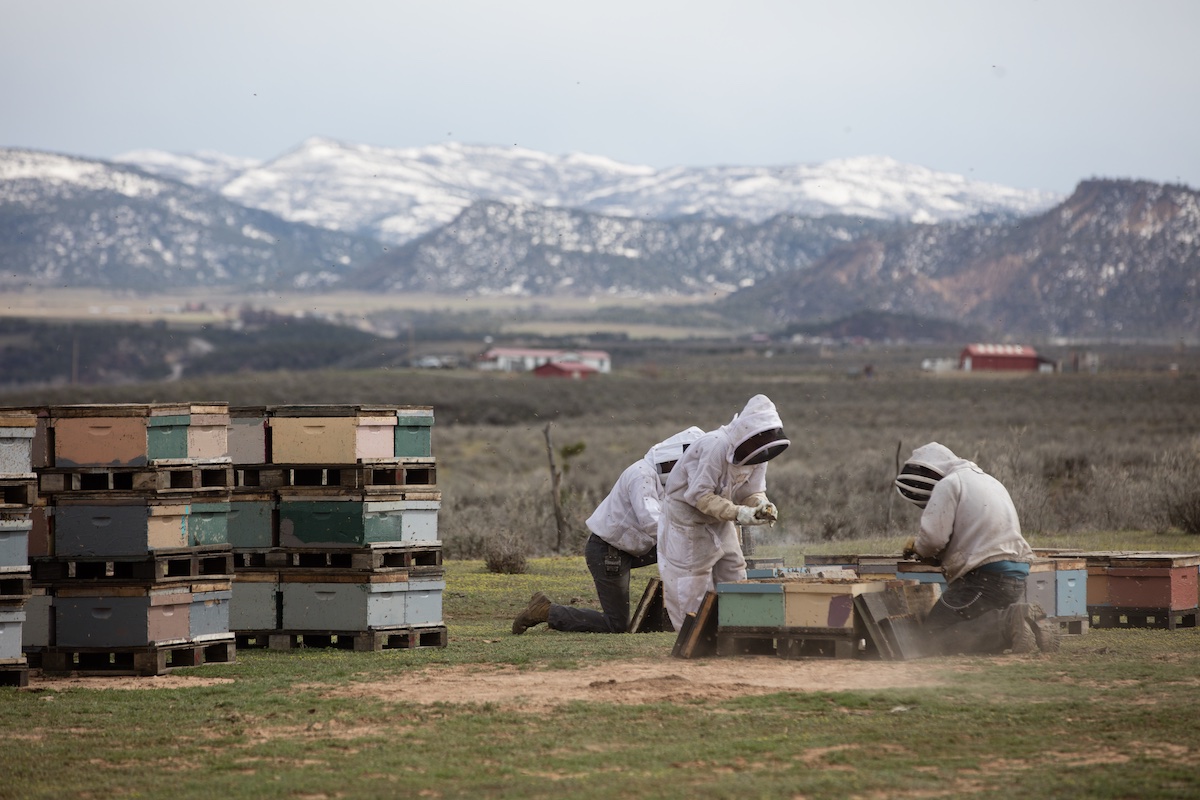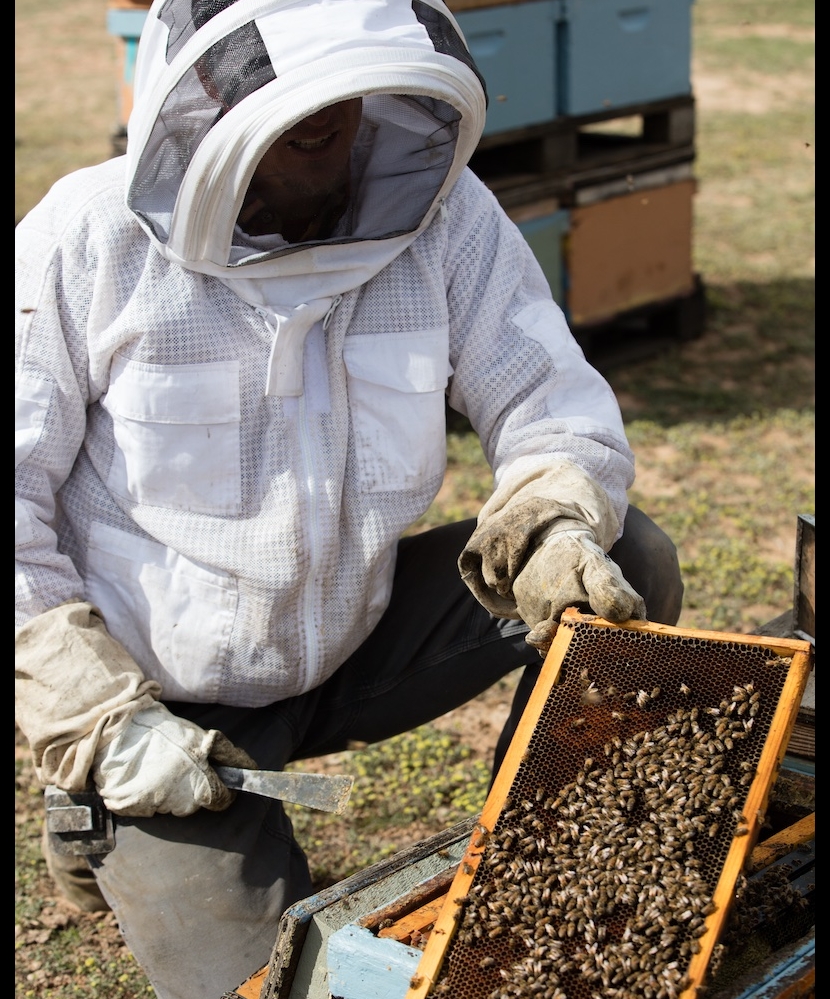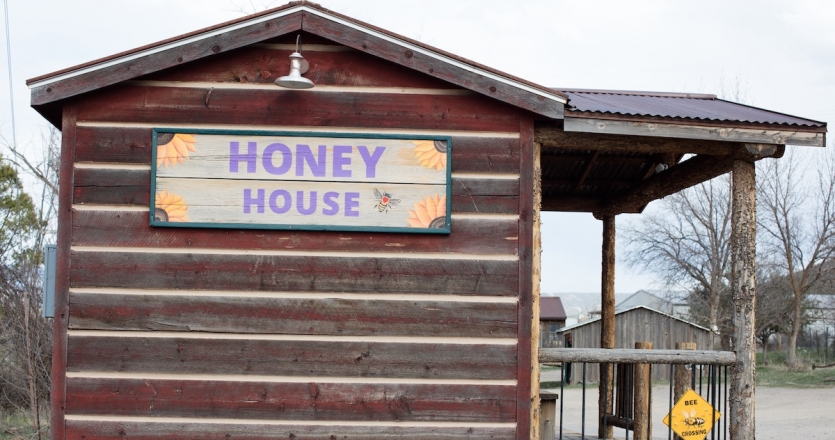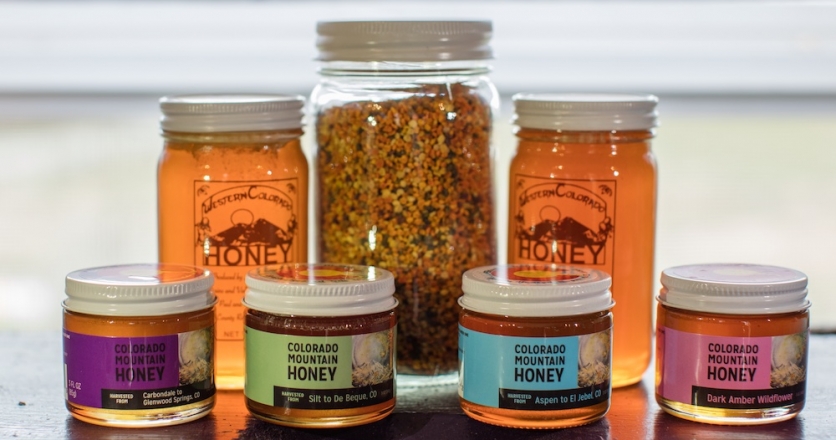Plight of the Bees
It’s a bluebird day in Silt, and Derrick Mannes and I are surrounded. Glowing jars of honey and bricks of buttery beeswax line the shelves of the Honey House, where his company, Colorado Mountain Honey, sells regionally specific blends, such as Skier’s Delight (a variety harvested from Aspen to El Jebel) and Liquid Gold (harvested from Carbondale to Glenwood Springs).
Mannes is a cowboy of sorts—except the livestock he wrangles are bees, numbering up to three million. His hands wave passionately as he shares stories from 27 years as a professional beekeeper.
“Just like the cowboys and the sheep herders,” he says, “I take my bees up into the mountains.” He describes the harrowing mountain roads into the White River National Forest he navigates, towing thousands of pounds of buzzing hives to 100-plus locations from Aspen to Debeque.
Today, though, we’re talking about a more treacherous journey: that of the bee in a changing climate. Bee populations are rapidly declining around the world, Mannes tells me, “but they’re not just disappearing. There’s cause and effect.” Their plight is complex, and likely linked to the existential threats of a failing food system.
Honey bees face climate challenges
Bees play a vital role in agriculture. They are the great connectors between flowering plants, generously pollinating one-third of our food crops. Humans’ relationship with bees dates back 9,000 years to Africa—honey has been found in Egyptian tombs.
By comparison, beekeeping in Colorado is relatively new: European settlers brought the Western honey bee, Apis mellifera, here about 100 years ago to pollinate their European crops like alfalfa. However, Colorado has been home to wild bees for thousands of years. Our microclimates are so diverse that we boast a staggering 950 bee species, many of which are native. While alarm bells have been ringing around the plight of honey bees, the compounding impacts of climate change make all bees vulnerable in ways we can’t yet predict.
Though Mannes’s mentors passed down their local beekeeping knowledge, “lots of things have changed in our valley in the last 100 years,” he says. “Agriculture has completely changed.”
Industrial agriculture came to rely upon, and commodify, the commercial honey bee—they now contribute $15 billion worth of crop pollination services in the United States each year. But industrial agriculture paradoxically also ushered in an onslaught of threats for honey bees and wild bees alike: a reliance on harmful agrichemicals, monoculture cropping that leads to poor and imbalanced diets for bees, habitat destruction, pests, and pathogens. Climate change only exacerbates these interrelated factors.
“When your livelihood depends on it, you start to feel and understand the connection between everything—between plants, insects, water, weather, climate, altitude.” Mannes smiles. “It’s amazing. But there’s such a challenge to raising life in all those different variables.”
His careful observation of relationships also reveals an undeniable shift in climate. For example, most plants and pollinators co-evolved together, resulting in synchronously timed life cycles. This ancient clockwork is being disrupted by climate change: Plants are blooming out of season, or not at all, leaving pollinators with little to no food—a phenomenon being documented worldwide. Mannes now has little to go off of when trying to time the movements of his hives in sync with increasingly erratic blooming periods.
Extreme weather also changes the nature of plants. “Obviously, water is getting more scarce here,” he reflects, “and honey is essentially nectar and water. I’ve noticed the drier and hotter a year is, the less nectar flowers produce.”
Increasingly stressed plants produce less nutritious nectar and pollen, impacting bee health as well as honey production: Mannes recently found handwritten records that show that his grandfather’s hives produced twice as much honey as his own currently do. To ensure the resilience of his whole operation, each year Mannes diversifies the locations of his hives in case one microclimate has better forage than another. “It’s a lot of work,” he says.
With climate change, beekeeping worldwide could be changing too. Additional climate impacts like wildfire, flooding, and heat waves can destroy swaths of colonies as well as impact a bee’s ability to forage for food and store honey. Beekeepers around the world report a heavier reliance on supplemental feeding with sugar water so their bees don’t starve during climate shocks, as well as increased occurrence of “transhumance,” or moving bees in search of healthy forage and friendlier climes.
Finally, you’d be hard pressed to talk to a beekeeper without hearing of the Varroa destructor mite, which climate-stressed bee populations may have a harder time combating. Scaling from bee to human, “imagine ticks the size of a basketball that you can’t get off,” Mannes says of the parasitic mite. Through domestication, we’ve made the honey bee “just like a Labrador dog”—vulnerable to all sorts of health problems requiring the attention of experienced caregivers. The mite is a dangerous vector for lethal pathogens, so left untreated—which well-intentioned backyard beekeepers may do—colonies of sick bees will contaminate surrounding hives and wild bees alike.
Because of all this, Mannes pleads with would-be beekeepers: “If you really care about bees, don’t keep a hive. Instead, plant pollinator-friendly gardens on your property to increase the forage available for bees, especially our wild ones.”
Wild solutions needed
Though honey bees are his livelihood, Mannes is more concerned about wild bees. Because wild bees don’t produce honey and aren’t as valued for commercial pollination despite being important even for pollinating food crops, “there’s no one really looking out for them,” he laments.
Innovative beekeepers have been adapting for millennia, and will continue to receive support to do so. Wild bees, in contrast, aren’t under the care of invested beekeepers, so stopgaps like supplemental feeding, transhumance, and Varroa mite treatment aren’t done for them. In Colorado alone, we’ve already seen a 72 percent decline in one species of bumblebee in just 25 years, likely a bellwether of what’s to come. Native flora depend on wild pollinators, and as climate change disrupts the very ecosystems and food sources wild bees coevolved with, all parts of this finely honed system are at risk.
Is there a solution? Transforming food systems and land use is a place to start—prioritizing forms of agriculture that mimic nature’s complexity, providing diverse crop species to bolster bee diets, and eschewing agrichemicals. Keeping ecosystems intact through land conservation and planting pollinator-friendly gardens are also important. But “saving the bees” requires more than a silver bullet. Our actions toward the climate are delicately woven into a larger system of complex relationships. Bees’ resilience, and ultimate survival, depends on addressing the root causes of climate change and challenging a system that reserves protection and value for commodities alone.
But while it’s easy to despair, there’s always room for joy. When I ask Mannes what his favorite part of beekeeping is, he grins. “It’s everything! The smell, the bees, the observation. It’s like Christmas every time I open the hive.” He’s fascinated by how Colorado’s wealth of microclimates translates to a diversity of flowers from which the bees can make endless flavors and colors of honey, which change every year.
Back in the Honey House, I’m floored by the immense variety on display. Honey made from clover is almost transparent, with a bright, languid sweetness. Another made from aphid honeydew and wildflowers boasts an amber honey that is molasses thick and tastes a bit like pancakes. My biggest prize, though, is a jar full of bee pollen—both edible and medicinal. Differences in kernel color represent each bee’s unique hankering for certain types of flowers. I love the idea of a bee waking up one morning with a craving for dandelions in my backyard, while another seeks out wild alpine strawberries.
Surrounded by such sweetness, it’s hard to imagine a world without bees. Such a world surely would be destitute—devoid of honey, flowering food crops, and the native lupine and rabbitbrush that color Colorado’s mountainsides. Our own survival, even, is intertwined with pollinators. Could it be time for us to place value beyond commodities and into the commonwealth? To be collective caregivers in reciprocity with the natural world regardless of economic value, which would mean transforming our food systems, checking capitalism, and acting on climate change. Wouldn’t that be a truly sweet blend—one part accountability, two parts action, and a teaspoon of honey to wash it all down.
Thank you to Aspen beekeeper and local ski patrol legend Ed Colby, who also informed this piece. Check out Colby’s book, A Beekeeper’s Life, on his adventures as a local beekeeper.”
Bolstering Bees
• Keep bees healthy and fed. Support diversified, ecological farms and advocate for appropriate land conservation.
• Learn to recognize Colorado wild bees, which include bumblebees, mason bees, and carpenter bees. The first step in advocacy is knowing what you’re fighting for.
• Plant a pollinator-friendly garden.
• Eat local honey. Stop by Colorado Mountain Honey’s Honey House in Silt, or find its products at Natural Grocery or online at coloradomountainhoney.com. When at the Marble Distillery’s tasting room in Carbondale, order the honey blend: the distillery’s own Hoover’s Revenge rye whiskey mixed with honey and comb from its local hives. Check out Leaf & Hive’s probiotic-infused Honeybrew, a smooth, flavorful, and utterly unique alcoholic beverage with health benefits. Produced in Santa Fe with honey from local apiaries (and co-owned by Roaring Fork Valley resident Annalee Gooding), it is currently available at Sopris Liquor in Carbondale and online at leafandhive.com.
What’s the Buzz?
• Check out Black Hives Matter, honoring the legacy of Black beekeepers in the U.S.
• To produce one pound of honey, bees must visit about two million flowers.
• There are 19,500 described bee species worldwide, and Colorado is the fifth most diverse U.S. state in terms of bee species.
• Consuming local honey may be healthier for you than commercial varieties. Most local beekeepers don’t expose their honey to high heat, which breaks down the micronutrients of vitamins and minerals in it. And eating local honey may help fight allergies by exposing us to the pollen of local flowering plants. ❧









